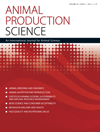
Animal Production Science
Volume 52 Number 1 2012
AN11153 Genetic analysis of feet and leg traits of Australian Angus cattle using linear and threshold models
A genetic evaluation system for structural soundness traits, which play a major role in determining the length of productive life of a breeding cow and the incidence of bull breakdown in breeding herds, was developed. A newly developed genetic evaluation system would predict the estimated breeding values (EBVs) for the structural trait scoring system with intermediate desirable score and thereby enable the breeders to select cattle with higher EBVs (as in other production traits) to improve the structural soundness in a herd.
AN11146 Reproductive performance and survival of Chinese Holstein dairy cows in central China
The Chinese dairy industry is expanding rapidly but few studies have examined the fertility and longevity of the cows. This study examined Chinese Holstein cows in central China and found they had relatively poor fertility associated with summer heat stress, which increased the risk of culling, resulting in a shortened lifespan. As fertility was poor compared with other countries globally, better management and a greater emphasis on genetic selection for fertility and longevity traits are required in the future.
AN11214 Feeding management and feeds on dairy farms in New South Wales and Victoria
Australian dairy farmers are increasingly feeding a wider variety of feedstuffs to their dairy cows to maximise milk production and decrease feed costs. Our survey of 100 dairy farms in NSW and Victoria summarises the feeding practices on these farms, including pasture grazed and supplements offered. Results from this survey not only support recent industry data that dairy farmers are feeding an increasing amount of concentrates to their milking herds but also highlights problems with the feeding rates of some supplements being offered.
AN11033 Damara sheep have higher digestible energy intake than Merino sheep when fed low-quality or high-quality feed
The Damara is a low-maintenance breed of sheep that anecdotally outperforms Merinos in the harsh environments encountered in the pastoral zone of Australia. This study investigated the performance of Damara and Merino wethers fed low-quality and high-quality diets and found that Damaras ate more high-quality feed and extracted more nutrients from the low-quality feed, thus enabling them to outperform the Merinos. The presence of such variation between genotypes offers potential for selective breeding and development of commercial lines of sheep.
AN11086 The allometric relationship between mean fibre diameter of mohair and the fleece-free liveweight of Angora goats over their lifetime
Fibre diameter is the main determinant of the price for mohair, but there is little information about lifetime changes in mohair fibre diameter. We found over the lifetime of Angora goats that mohair fibre diameter was related to their liveweight and that age was not important. The findings indicate that management that affects the liveweight and weaning weight have lifetime effects on fibre diameter and therefore the value of mohair and the profitability of the mohair enterprise.
AN11096 Synthetic and natural polyphenols with antioxidant properties stimulate rumen microbial growth in vitro
The improvement of rumen microbial protein synthesis is of paramount importance for better utilisation of feed resources in ruminants. This study demonstrates that the use of some synthetic or natural phenolic compounds can significantly increase the growth efficiency of rumen microbes, most likely because of their antioxidant properties. This paper covers an area of knowledge largely unexplored.
AN11183 Effects of growth stage and position within the beam in the structure and chemical composition of sika deer (Cervus nippon) antlers
This study correlated structural properties and chemical composition of sika deer antler with antler developmental stage and different sections. Research findings provide useful basic information and identify biomarkers for the association between structural properties and chemical composition during antler growth period. These results will also facilitate efficient production of high quality antlers for food consumption and as pharmaceutical agents.
AN11140 The interaction between ovulation rate and embryo survival in determining prolificacy of different strains of obese swine with gene polymorphisms for leptin receptors
Swine obese genotypes have a lowered prolificacy when compared with lean genotypes. The current study evidences intrinsic factors, related to oocyte/embryo quality and/or uterine space or environment, as determinant factors lowering such prolificacy. Thus, future strategies for increasing reproductive yields may be focused on such issues.
AN11220 Genetic mapping of quantitative trait loci affecting bodyweight on chromosome 1 in a commercial strain of Japanese quail
The Japanese quail is a commercial bird used for intensive egg and meat production. This study found genomic regions underlying liveweight variation in a commercial strain of Japanese quail. If validated, the identified markers may be used in commercial breeding programs to improve the growth rate of Japanese quail.
AN11124 The effect of sieve agitators and dispersing agent on the method of determining and expressing fineness of feed materials by sieving
The method used to determine the particle size of cereal grains will have a significant impact on the results reported by researchers. Researchers, laboratories, and feed mills that analyse samples without sieve agitators or a dispersing agent could overestimate the particle size (dgw) and underestimate the distribution of the particles (Sgw) of the sample. The results of the experiments clearly showed the benefit of adding sieve agitators and a dispersing agent to facilitate the flow of material through the sieves, so that a better estimate of the micron diameter and particle size distribution could be achieved.



